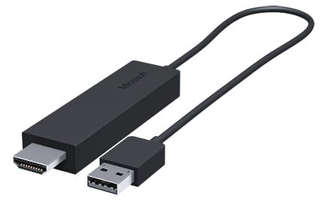Microsoft Wireless Display Adapter Review
Microsoft's Wireless Display Adapter makes it easy to stream video from your mobile device to the big screen and delivers excellent video quality.
Why you can trust Tom's Guide

Mirroring your phone, tablet or PC screen to your TV is supposed to be easy, using a pair of wireless technologies called Miracast and WiDi that are built into many newer mobiles and laptops. But in our tests at Tom's Guide, we found the process to be nightmarish. Enter the Microsoft Wireless Display Adapter ($60), which commands a high price but does exactly what it promises to do. Unlike most other Miracast/WiDi receivers on the market, the Wireless Display Adapter works — and quite well, based on my tests.
Who it's for
People who want a no-nonsense way to mirror their PC or phone screens for media or productivity (but not gaming).
Design

The Microsoft Wireless Display Adapter is a small HDMI stick that's thinner than a Chromecast, but just a touch wider. It's powered by a short (about 12-inch) attached USB cable, so if you have an older TV that lacks nearby USB ports, you'll need to buy a extension cord and power adapter yourself. The Wireless Display Adapter works with many newer Intel-based Windows 8.1 PCs and with mobile devices running Android versions 4.2 (Jelly Bean). Any Windows Phone with Miracast functionality will also work, a Microsoft representative told Tom's Guide.
Setup
There's no real setup for the Wireless Display Adapter. Just turn on your Android or Windows 8.1 device. (most PCs will work, although Miracast functions only on newer Windows Phones, like the Lumia 930)and activate screen mirroring (see how). Your smartphone, tablet or computer will connect to the Wireless Display Adapter and broadcast every action from your PC or mobile onto your TV screen — with no discernible lag.
MORE: How to Stream Video to a TV from a Mobile Device or Computer
How we tested
To test how well Microsoft's adapter worked, I mirrored the screens of a Dell XPS 13 laptop running Windows 8.1, a Google Nexus 10 tablet (running Android 4.4.4) and two popular smartphones: a Samsung Galaxy S5 (Android 4.4.2) and an HTC One M8 (Android 4.4.2). On each device, I tried out video streaming via Netflix as well as a game: Plant vs. Zombies 2 for the Android devices, and Age of Empires: Castle Siege on Windows.
Performance
To my delight, each device performed excellently with the Wireless Display Adapter. Past a few seconds of initial jittering, they streamed video, games and productivity software smoothly, just fractions of a second behind the source device. Watching Archer on Netflix was a joy (as always). Typing up documents in Google Docs was the same experience as it would have been if I had used a monitor attached by a cable.

The only caveat I found was that not all games ran equally well. I didn't encounter any slowdown or screen tearing in Age of Empires: Castle Siege, but the picture quality dropped considerably on the TV when I tried to scroll around the map very quickly. Miracast and WiDi technology weren't really intended for fast-paced gaming. It's best to keep in mind that the Wireless Display Adapter works better for general screen casting than as a game peripheral.
Bottom Line
Miracast and WiDi evangelists can rest a little easier: A product that makes the technologies as user-friendly as their manufacturers claim has finally arrived. Whether the device is really worth the money is up to you. A Chromecast, for example, costs $35 and can mirror content from a growing number of online streaming services, as well as the exact screen contents of mobiles running Android 4.4.2 or higher.
But to get an exact replica of your PC and mobile-device screens, Microsoft's Wireless Display Adapter is by far the best option right now.
Want to save some money on your next Microsoft purchase? Be sure to check out our Microsoft discount codes for the latest deals.
Sign up to get the BEST of Tom's Guide direct to your inbox.
Here at Tom’s Guide our expert editors are committed to bringing you the best news, reviews and guides to help you stay informed and ahead of the curve!
Marshall Honorof is a senior editor for Tom's Guide, overseeing the site's coverage of gaming hardware and software. He comes from a science writing background, having studied paleomammalogy, biological anthropology, and the history of science and technology. After hours, you can find him practicing taekwondo or doing deep dives on classic sci-fi.
